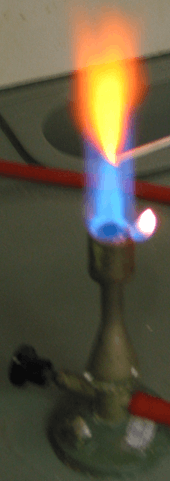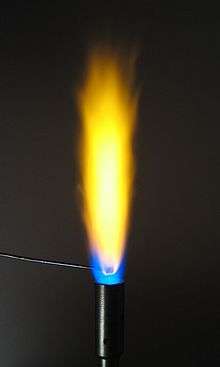Pyrotechnic colorant




A pyrotechnic colorant is a chemical compound which causes a flame to burn with a particular color. These are used to create the colors in pyrotechnic compositions like fireworks and colored fires. The color-producing species are usually created from other chemicals during the reaction. Metal salts are commonly used; elemental metals are used rarely (e.g. copper for blue flames).
The color of the flame is dependent on the metal cation; the anion of the salt has very little direct influence. The anions however influence the flame temperature, both by increasing it (e.g. nitrates, chlorates) and decreasing it (e.g. carbonates, oxalates), indirectly influencing the flame brightness and brilliancy. For temperature-decreasing additives, the limit of colorant may be about 10–20 wt.% of the composition.[1]
Some common examples are:
| Color | Compound name | Chemical formula | Notes | |
|---|---|---|---|---|
| Red | Strontium nitrate | Sr(NO3)2 | Common. Used with chlorine donors. Excellent red, especially with metal fuels. Used in many compositions including road flares. | |
| Red | Strontium carbonate | SrCO3 | Common. Produces good red. Slows burning of compositions, decomposes yielding carbon dioxide. Fire retardant in gunpowders. Inexpensive, non-hygroscopic, neutralizes acids. Superior over strontium oxalate in absence of magnesium. | |
| Red | Strontium oxalate | SrC2O4 | Decomposes yielding carbon dioxide and carbon monoxide. In presence of magnesium fuel, carbon monoxide reduces particles of magnesium oxide, yielding gaseous magnesium and eliminating the black body radiation of the MgO particles, resulting in clearer color. | |
| Red | Strontium sulfate | SrSO4 | Common. High-temperature oxidizer. Used in strobe mixtures and some metal-based red compositions. | |
| Red | Strontium chloride | SrCl2 | Common. Produces bright red flame. | |
| Orange | Calcium carbonate | CaCO3 | Produces orange flame. Yields carbon dioxide on decomposition. Often used in toy fireworks as a substitute for strontium. | |
| Orange | Calcium chloride | CaCl2 | ||
| Orange | Calcium sulfate | CaSO4 | High-temperature oxidizer. Excellent orange source in strobe compositions. | |
| Orange | Hydrated calcium sulfate | CaSO4(H2O)x* | ||
| Gold/Yellow | Charcoal powder | |||
| Yellow | Sodium bicarbonate | NaHCO3 | Compatible with potassium chlorate. Less burning rate decrease than sodium carbonate. Incompatible with magnesium and aluminium, reacts evolving hydrogen gas. | |
| Yellow | Sodium carbonate | Na2CO3 | Hygroscopic. Significantly decreases burning rate, decomposes evolving carbon dioxide. Strongly alkaline. Very effective colorant, can be used in small amounts. Corrodes magnesium and aluminium, incompatible with them. | |
| Yellow | Sodium chloride | NaCl | Loses hygroscopicity on heating. Corrodes metals. | |
| Yellow | Sodium oxalate | Na2C2O4 | Non-hygroscopic. Slightly reacts with magnesium, no reaction with aluminium. | |
| Yellow | Sodium nitrate | NaNO3 | Also acts as oxidizer. Bright flame, used for illumination. | |
| Yellow | Cryolite | Na3AlF6 | One of the few sodium salts that is nonhygroscopic and insoluble in water. | |
| Green | Barium chloride | BaCl2 | ||
| Green | Barium chlorate | Ba(ClO3)2 | Classic exhibition green with shellac fuel. Sensitive to shock and friction. Oxidizer. | |
| Green | Barium carbonate | BaCO3 | A Pretty color when ammonium perchlorate is used as oxidizer. | |
| Green | Barium nitrate | Ba(NO3)2 | Not too strong effect. With chlorine donors yields green color, without chlorine burns white. In green compositions usually used with perchlorates. | |
| Green | Barium oxalate | BaC2O4 | ||
| Blue | Copper(I) chloride | CuCl | The Richest blue flame. Almost insoluble in water. | |
| Blue | Copper(I) oxide | Cu2O | Lowest cost blue colorant. | |
| Blue | Copper(II) oxide | CuO | Used with chlorine donors. Excellent in composite stars. | |
| Blue | Copper carbonate | CuCO3 | Best when used with ammonium perchlorate. | |
| Blue | Basic copper carbonate | CuCO3·Cu(OH)2, 2 CuCO3·Cu(OH)2 | Occurs naturally as malachite and azurite. Good with ammonium perchlorate and for high-temperature flames with presence of hydrogen chloride. Not easily airborne, less poisonous than Paris Green. | |
| Blue | Copper oxychloride | 3CuO·CuCl2 | Good blue colorant with suitable chlorine donor. | |
| Blue | Paris Green | Cu(CH3COO)2.3Cu(AsO2)2 | Copper acetoarsenite, Emerald Green. Toxic. With potassium perchlorate produces the best blue colors. Non-hygroscopic. Fine powder readily becomes airborne; toxic inhalation hazard. | |
| Blue | Copper arsenite | CuHAsO3 | Almost non-hygroscopic. Almost as good colorant as copper acetoarsenite. Toxic. Can be used with chlorate oxidizers. | |
| Blue | Copper sulfate | CuSO4·5 H2O | Can be used with nitrates and perchlorates. Acidic, incompatible with chlorates. With red phosphorus in presence of moisture liberates heat, may spontaneously ignite. Less expensive than copper acetoarsenite. Anhydrous copper sulfate is hygroscopic, can be used as a desiccant. With ammonium perchlorate produces almost as pretty blue color as achievable with copper acetoarsenite. | |
| Blue | Copper metal | Cu | Rarely used, other compounds are easier to work with. Yields pretty blue color in ammonium perchlorate based compositions; but reacts with ammonium perchlorate and liberates ammonia in presence of moisture. The composition must be kept dry. | |
| Purple | Combination of red and blue compounds | Sr+Cu | ||
| Purple | Rubidium compounds | Rb | rarely used | |
| Silver/White | Aluminium powder | Al | ||
| Silver/White | Magnesium powder | Mg | ||
| Silver/White | Titanium powder | Ti | ||
| Silver/White | Antimony (III) sulfide | Sb2S3 | ||
| Infrared | Caesium nitrate | CsNO3 | two powerful spectral lines at 852.113 nm and 894.347 nm | |
| Infrared | Rubidium nitrate | RbNO3 |
The * indicates that the compound will burn orange where x=0,2,3,5.
Radiating species
Despite the wide numbers of metal ion donors, they serve to form only a few atomic and molecular species that are useful as light emitters.[2]
In many cases, chlorine donors have to be added in order to achieve sufficiently deep colors, as the desired emitting molecules have to be generated.
Some color emitters are of atomic nature (e.g. lithium, sodium). Presence of chlorine, and the reaction to monochlorides, may actually impair their color purity or intensity.
At high temperatures, the atoms will ionize. The emission spectra of ions are different than of neutral atoms; the ions may emit in undesired spectral ranges. For example, Ba+ emits in blue wavelengths. Ionization can be suppressed by addition of an easier-to-ionize metal with weak visible emission of its own, e.g. potassium; the potassium atoms then act as electron donors, neutralizing the barium ions.[3]
The color blue is notoriously difficult to produce in fireworks, as the copper compounds need to be heated at a specific temperature for the optimal shade of blue to be produced. Thus, a deep, rich blue is usually viewed as the mark of an experienced fireworks maker.
Care should be taken to avoid formation of solid particles in the flame zone, whether metal oxides or carbon; incandescent solid particles emit black body radiation that causes "washing out" of the colors. Addition of aluminium raises the flame temperature but also leads to formation of solid incandescent particles of aluminium oxide and molten aluminium. Magnesium has less such effect and is therefore more suitable for colored flames; it is more volatile than aluminium and more likely to be present as vapors than as particulates. Formation of solid particles of magnesium oxide can further be inhibited by presence of carbon monoxide, either by negative oxygen balance of the composition in presence of organic fuels, or by addition of the colorant in the form of an oxalate, which decomposes to carbon dioxide and carbon monoxide; the carbon monoxide reacts with the magnesium oxide particles to gaseous magnesium and gaseous carbon dioxide.
| Color | Emitter | Wavelengths | Notes |
|---|---|---|---|
| Yellow | Sodium (D-line) | 589 nm | Very strong, overpowers other colors, avoid contamination |
| Orange | CaCl (molecular bands) | most intense: 591–599 nm and 603–608 nm, and others | |
| Red | SrCl (molecular bands) | a: 617–623 nm b: 627–635 nm c: 640–646 nm |
The SrCl species tends to be oxidized to less desirable SrO; strontium-containing compositions are therefore usually formulated to be oxygen-deficient.[3] |
| Red | SrOH(?) (molecular bands) | 600–613 nm | |
| Red | Li (atomic spectral lines) | ||
| Green | BaCl (molecular bands) | a: 511–515 nm b: 524–528 nm d: 530–533 nm |
Lines of BaOH and BaO are also present, emitting in yellow and yellowish-green (487, 512, 740, 828, and 867 nm for BaOH, 549, 564, 604 and 649 for BaO). The BaOH lines are much stronger than the BaO lines. In absence of chlorine, the BaCl lines are not present and only the BaOH and BaO lines are visible.
|
| Blue | CuCl (molecular bands) | several intense bands between 403–456 nm, less intense at 460–530 nm | Low dissociation energy of copper compounds causes presence of free copper atoms in the flame, weakly emitting in green (lines between 325–522 nm). In presence of chlorine, CuCl is formed, emitting strongly in blue. At higher temperatures CuCl dissociates and lines of atomic copper are present in the spectrum; CuO and CuOH are also formed, emitting molecular bands at green-yellow (535–555 nm) for CuOH and at orange-red (580–655 nm) for CuOH. Adequate control of temperature is therefore required for blue-burning compositions. |
| Infrared | Carbon particles | black body radiation | For good broadband infrared output, compositions producing lots of heat and carbon particles are required. The burning temperature should be lower than of visible-illuminating compounds. The intensity of the emitted radiation depends on the burn rate. Temperature can be increased by addition of magnesium. A magnesium/Teflon/Viton composition is common for missile decoy flares.[4] |
| Infrared | CO2 (molecular bands) | mostly 4300 nm | Produced by carbon-containing fuels. |
| Infrared | Cs (atomic spectral lines) | two powerful spectral lines at 852.113 nm and 894.347 nm | Used in infrared illumination compositions. Metal is avoided in the compositions to prevent formation of bright, visible-radiating particles.[5] |
| Infrared | Rb (atomic spectral lines) | spectral lines in near-infrared | Used in infrared illumination compositions, less commonly than cesium. |
References
- ↑ B. J. Kosanke et al. Pyrotechnic Chemistry. Volume 4 of Pyrotechnic reference series, Journal of Pyrotechnics, 2004 ISBN 1889526150, p. 30
- ↑ "The Physics of Coloured Fireworks". Cc.oulu.fi. Retrieved 2010-03-23.
- 1 2 3 Michael S. Russell The chemistry of fireworks, Royal Society of Chemistry, 2009 ISBN 0-85404-127-3, p. 85
- ↑ Jai Prakash Agrawal High Energy Materials: Propellants, Explosives and Pyrotechnics, Wiley-VCH, 2010 ISBN 3-527-32610-3, p. 349
- ↑ B. J. Kosanke et al. Pyrotechnic Chemistry, Journal of Pyrotechnics, 2004 ISBN 1889526150, p. 58